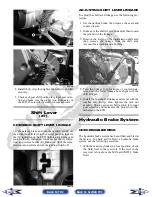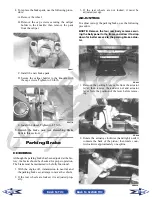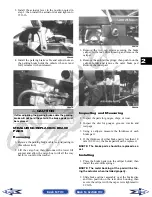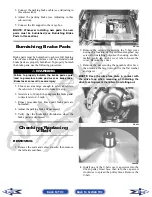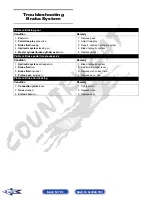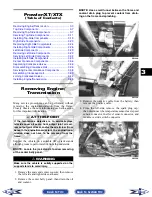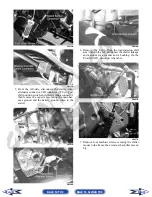
2-5
2
3. Place the valve adjuster onto the jam nut securing
the tappet adjuster screw; then rotate the valve
adjuster dial clockwise until the end is seated in
the tappet adjuster screw.
4. While holding the valve adjuster dial in place, use
the valve adjuster handle and loosen the jam nut;
then rotate the tappet adjuster screw clockwise
until friction is felt.
5. Align the valve adjuster handle with one of the
marks on the valve adjuster dial.
6. While holding the valve adjuster handle in place,
rotate the valve adjuster dial counterclockwise
until proper valve/tappet clearance is attained.
NOTE: Refer to the appropriate specifications in
Feeler Gauge Procedure sub-section for the proper
valve/tappet clearance.
NOTE: Rotating the valve adjuster dial counter-
clockwise will open the valve/tappet clearance by
0.05 mm (0.002 in.) per mark.
7. While holding the adjuster dial at the proper clear-
ance setting, tighten the jam nut securely with the
valve adjuster handle.
8. Place the two tappet covers with O-rings into posi-
tion. Tighten the cap screws securely.
CF006A
CF005
9. Install the spark plug; then install the timing
inspection plug.
Testing Engine
Compression
To test engine compression, use the following proce-
dure.
NOTE: The engine must be warm and the battery
must be fully charged for this test.
NOTE: The seats and center console must be
removed for this procedure.
1. Remove the high tension lead from the spark plug.
2. Using compressed air, blow any debris from
around the spark plug.
3. Remove the spark plug; then attach the high ten-
sion lead to the plug and ground the plug on the
cylinder head well away from the spark plug hole.
4. Attach the Compression Tester Kit.
5. While holding the throttle in the full-open posi-
tion, crank the engine over with the electric starter
until the gauge stops climbing (five to 10 compres-
sion strokes).
NOTE: The compression should be within a
range of 155-170 psi in the full-open throttle posi-
tion.
6. If compression is abnormally low, inspect the
following items.
A. Starter cranks engine over.
B. Gauge is functioning properly.
C. Throttle lever in the full-open position.
D. Valve/tappet clearance correct.
E. Valve bent or burned.
F. Valve seat burned.
NOTE: To service valves, see Section 3.
7. Pour approximately 30 ml (1 fl oz) of oil into the
spark plug hole, reattach the gauge, and retest
compression.
8. If compression is now evident, service the piston
rings (see Section 3).
! WARNING
Always wear safety glasses when using compressed
air.
Back to TOC
Back to Section TOC
Next
Back


















